58TH ANNUAL CONFERENCE, Conchal, Costa Rica, 20-24 May 2019Agenda Item: B.5.4 – WP No. 89ATFM and A-CDM Implementation in AsiaPresented by TOC |
Summary
The concept of ATFM/ACDM in Asia is fairly new. While the concept of a single ATFM entity to serve a region works well in Europe and North America, a centralized ATFM Unit (ATFMU) approach is not yet practicable for the Asia/Pacific region. The key concept of Asia/Pacific ATFM operation is a multi-nodal ATFM network. ICAO will be a key player in facilitating improvement in the region’s ATFM and A-CDM developments.
Introduction
1.1. Collaborative Decision Making (CDM) is a well-known concept, used within several segments of aviation. Airport CDM (A-CDM) is the operational approach for achieving an optimal turnaround process at airports. It is an end-to-end process from flight planning (ATC flight plan), push back, taxi, take off, landing and through to turn-around.
1.2. In the Asia/Pacific region, the A-CDM concept is relatively new compared to Europe and North America. Some airports are still unfamiliar with the concept (Final report pf APA-CDM/TF 3.2)
1.3. The 3rd Edition of the ICAO Manual on Collaborative Air Traffic Flow Management (Doc. 9971) was approved for publication in 2018. The updated document includes standardized terminology and phrases for use in Air Traffic Flow Management (ATFM) and A-CDM, and a new Part III – Airport Collaborative Decision-Making. The new Part III expanded the reach of collaboration described in Part I of the document, describing how CDM processes are applied to airport operations and aircraft turn-around.
1.4. In the 27th meeting of the Asia/Pacific Air Navigation Planning and Implementation Regional Group (APANPIRG/27) in Bangkok from the 5th to the 8th of September 2016 the A-CDM Task Force was established to assist States to overcome A-CDM implementation challenges. Also, a draft conclusion was made for the creation of a seminar on A-CDM. Some states were facing implementation challenges which included lack of guidance material and awareness and this seminar would enhance knowledge to overcome the challenges.
1.5. ICAO held the first meeting of the Asia/Pacific Aerodrome Collaborative Decision-Making Task Force (APA-CDM/TF) and a Seminar on A-CDM in Kunming, China from the 19th to the 21st April 2017 to support the implementation of A-CDM. The third meeting was held in August 2018 in Bali Indonesia.
1.6. The Asia/Pacific Framework for Collaborative ATFM, subsidiary to the Asia/Pacific Seamless ATM Plan, is intended to provide a common regional framework that addresses ATFM implementation and operational issues in the Asia/Pacific Region. There are a few key concepts used in the development of the framework that are relevant to A-CDM. It is vital to the success of connected ATFM and A-CDM processes.
1.7. This paper gives a short review of the A-CDM concept, especially the new Part III – Airport Collaborative Decision-Making (Doc9971) and the implementation of ATFM/A-CDM in Asia through the report of APA-CDM/TF, and some IFATCA policies related to ATFM/A-CDM.
Discussion
2.1. The CDM concept was first published in the Global Air Traffic Management Operational Concept (Doc 9854), First Edition, 2005.
2.1.1. CDM is a process applied to support other activities such as demand/capacity balancing. CDM can be applied across the timeline of activities from strategic planning (e.g. infrastructure investments) to real-time operations (Doc 9971 3th 2.1.1).
2.1.2. Sharing information is the most important enabler for CDM.
2.2. Air traffic flow management (ATFM) is an enabler of air traffic management (ATM) efficiency and effectiveness.
2.2.1. The CDM process is important for optimum ATFM services, because ATFM implementation implies working together to improve the overall performance of the ATM systems including aerodromes, ANSPs, airspace users (AUs) and stakeholders.
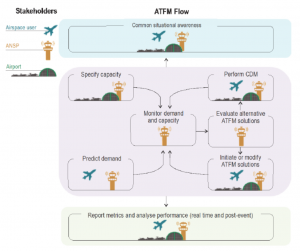
(Source: ICAO Doc 9971-Manual on Collaborative Air Traffic Flow Management [ATFM])
2.3. The process of A-CDM has developed from the overall philosophy of CDM in aviation. ICAO standards from Annex 14:
| A-CDM is a process that allows airport operators, aircraft operators, air traffic controllers, ground handling agents, pilots and air traffic flow managers to exchange operational information and work together to efficiently manage operations at airports and, where applicable, en route operations and planning. |
2.3.1. Doc 9971, PART Ⅲ, Part1.1.2 describes what is A-CDM:
| A-CDM allows aerodromes, aircraft operators, air traffic controllers, ground handling agents, pilots and air traffic flow managers to exchange operational information and work together to efficiently manage operations at aerodromes. |
2.3.2. The main objective of A-CDM is therefore to generate a common situational awareness that will foster improved decision-making.
2.3.3. According to the fifth edition of the Global Air Navigation Plan (GANP) and Aviation System Block Upgrades (ASBUs), A-CDM is addressed in one of the threads under the airport operations section of Performance Improvement Area. A-CDM is composed of two modules: B0-ACDM and B1-ACDM.
2.3.4. The B0-ACDM block is entitled “Improved Operations through Airport-CDM”. The module is also linked to two other Block 0 modules: B0-RSEQ and B0-SURF.
2.3.5. B0-RSEQ, entitled Improved Traffic Flow through Sequencing Arrival manager (AMAN) / Departure Manager (DMAN) will introduce system capabilities to provide assistance for runway sequencing and metering.
2.3.6. B0-SURF, entitled Safety and Efficiency of Surface Operations (A-SMGCS Level 1-2) and B1-SURF, will implement additional capabilities to the aerodrome surveillance environment to establish the position of individual flights and vehicles.
2.3.7. B1-ACDM is entitled Optimized Airport Operations through A-CDM Total Airport Management.
| The module is defined so as to enhance the planning and management of airport operations and allow their full integration for ATM using performance targets compliant with those of the surrounding airspace. This entails implementing collaborative airport operations planning and, where needed, an airport operations center (APOC). |
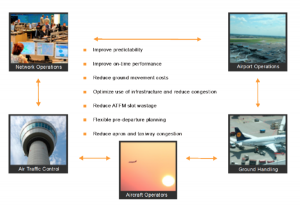
(Source: ICAO Doc 9971-Manual on Collaborative Air Traffic Flow Management [ATFM])
2.3.8. In efficiency terms, it is evident that any ATM system will benefit from being linked with A-CDM. For all iterations, accurate information about arrivals and departures will be one of the key benefits.
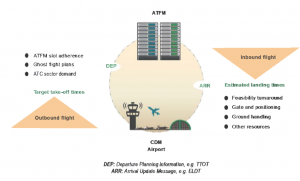
(Source: ICAO Doc 9971-Manual on Collaborative Air Traffic Flow Management [ATFM])
2.4. A-CDM implementations bring many benefits in operations, finance, and others. Safety is also benefited by A-CDM indirectly.
2.5. As mentioned in WP No.157 – Airport CDM (A-CDM) (55th IFATCA Annual Conference, Las Vegas, 2016), although several States all have their own A-CDM implementations, these can all be traced back to two different main A-CDM structures; the European and the US versions. The European process is focused on the turn-around process of flights at airports. On the other hand, the US Surface CDM focuses on the management of airport surface traffic flows and runway departure queues.
2.6. According to the report of the fifteenth meeting of the Asia/Pacific Area Traffic Forecasting Group (APA TFG), a growth rate of 4.8 percent per annum is expected for the period 2020-2030, resulting in a forecast of about 86 million transpacific passengers by the year 2030. (Doc.9961), The most likely Intra-Asia/Pacific passenger aircraft movements are expected to increase from some 1013.2 thousand in 2009 to about 2 889.3 thousand movements by the year 2030, at an average annual growth rate of 5.1 per cent. The growth rates for the intermediate periods of 2009-2020 and 2020-2030 are 5.6 and 4.5 per cent, respectively. The range of growth rates for low and high movement forecasts are provided in the Figure shown below. The Asia/Pacific seamless ATM plan ver2.0 was amended in 2016 and it also addresses the necessity of seamless ATM for Asia/Pacific due to the forecasted air traffic growth.

(Source: ICAO Doc 9961 – Asia/Pacific Area Traffic Forecasts 2010-2030)
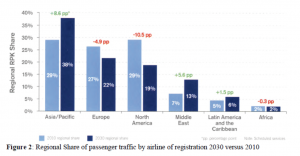
(Source: Asia/Pacific Seamless ATM Plan version 2.0)
2.6.1. The airspace of the Asia/Pacific Region, particularly that of South East Asia, is characterized by relatively small FIRs and correspondingly short flight transit times. There are 38 sovereign States and 50 FIRs in Asia/Pacific region; there is no overarching coordinating authority in the Asia/Pacific Region in the way that EUROCONTROL operates in Europe.
2.6.2. While the concept of a single ATFM entity to serve a region works well in Europe and North America, a centralized ATFM Unit (ATFMU) approach is not currently practicable for the Asia/Pacific region; therefore, the Asia/Pacific ATFM Steering Group developed a common regional ATFM framework with a framework that is quite different from those in Europe and the USA.
2.6.3. The key concept of Asia/Pacific ATFM framework is a multi-nodal ATFM network. This virtual ATFM platform has no central network management. The concept is envisaged as interconnected States and/or sub-Regional groups operating in an ATFM network without the need for any central, physical facility providing the network management function. It is developed as a collaborative effort between Singapore and industry partners, later expanded to involve Hong Kong, China, Malaysia and Thailand.
2.6.4. In this concept, each ANSP operates an independent, virtual ATFM/CDM node (they are responsible for ATFM/CDM within their area of responsibility) supported by an interconnected information-sharing framework. It is proposed that the flows of air traffic will then be effectively managed based on a common set of agreed principles among the participating ANSPs and airports. A node comprising of the ANSP and associated airports is expected to be able to manage the demand and capacity through adjustments in aircraft Calculated Landing Times (CLDTs) which will in turn generate Calculated Take Off Times (CTOTs) for particular aircraft at the departure airport.
2.6.5. The ANSP performs demand and capacity balancing within their own area of authority and where ATFM measures require participation of regional and international flights, the flows will be managed by the agreed coordination procedures.
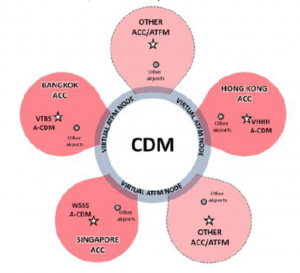
(Source: ICAO Bangkok Asia/Pacific Framework for Collaborative Air Traffic Flow Management)
2.6.6. Key components of the cross-border ATFM/CDM concept, to be considered in conjunction with the Regional ATFM concept of operation and Regional ATFM Framework, are:
Multi-nodal stakeholders interconnected via virtual communication framework
- Each ANSP has an independent ATFM System.
- Each ANSP independently manages demand/capacity at its own airport(s).
- Common agreement to share essential data for ATFM by all multi-nodal stakeholders.
- Stakeholders/ANSPs communicate via existing Internet/Telecommunications networks.
- Harmonized and integrated data exchange between all stakeholders in the multi-nodal network.
Specify Capacity and Predict Demand
- Demand Prediction – Flight progress is via manual input or automated data feed (e.g., FDP or AFTN).
- Capacity Management – Inputs from FMP and FOC are via ATFM web-based interface.
Evaluate Alternatives, Initiate/Modify ATFM Measures
- Aircraft Operators manage the ATFM Measures, such as delays, assigned to flights.
- Aircraft Operators perform CDM with Airport Operators for ground/surface delay intent.
- Slot assignments can be viewed via software web interface and notifications.
2.7. While the multi-nodal framework suits the current situation in Asia and has allowed for the development of ATFM even in the absence of an overarching authority, its characteristics may present some challenges and these should be addressed during its implementation.
2.7.1. The multi-nodal network will rely on the accurate and timely transmission of aeronautical data between ATS units in order to pass on CTOTs for enforcement. In the future, information sharing is expected to be improved; however, currently electronic communication between FIRs remains a challenge even for the larger ANSPs and is often subject to irregularities and ambiguities. If CTOTs are not shared with the appropriate ATS unit in a timely manner, flights may depart too early or late and affect the flow management at their destination.
2.7.2. With no overarching authority, the multi-nodal network has no single body to act as an arbiter; instead, it relies on the States upholding the bilateral agreements and enforcing CTOTs. Difficulties may arise when flights are subject to more than one flow restriction imposed by more than one State unless there are unambiguous procedures for handling such situations. All ATS units must understand the procedure and it must be enforced in a consistent manner or flights may arrive at their destination earlier or later than expected.
2.8. The APAC Seamless ATM Plan Phase1 expected that with the implementation of A-CDM, all high-density aerodromes should operate an A-CDM serving the major traffic flow and busiest city pairs, with priority implementation for the busiest Asia/Pacific aerodromes by November 2015.
2.9. By the report of ICAO Asia/Pacific Regional Office at APA-CDM/TF/3, A-CDM applicable Administrations include 19 of 40 APAC Administrations, and regional overall implementation is 28%, furthermore, only 2 administrations (China, Singapore) implemented at 100%. Bhutan and Pakistan have no plans for A-CDM as it has been reported by these States that their airports will not implement A-CDM.
2.10. A survey questionnaire about A-CDM among Asia/Pacific States was conducted and 15 States responded to it. Some results were reported at APA-CDM/TF/3 and are shown below. The results clearly show that a majority (82%) of the respondents do have a plan for how A-CDM shall be implemented from the standpoint of how the program/project should be managed which is encouraging. The next results show that the majority of the airports have already implemented ACDM or are either well underway or ready to launch the A-CDM program/project.
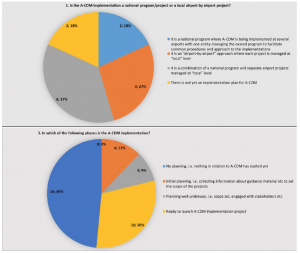
(Source: Report on ICAO APAC A-CDM survey review APA-CDM/TF/3)
2.11. IFATCA has existing provisional policy on air traffic flow management – adherence (IFATCA TPM, 2018, ATS 3.6):
|
IFATCA recognises the potentially dangerous situations that can arise when slot times are not adhered to. In the EUR region ATFM utilises departure slot times as a means of regulating air traffic and that when a departure slot time is used, the time should be passed to the ATC unit at the departure airfield. It is the responsibility of the aircraft operator to be ready for departure to meet the assigned ATFM departure slot. Civil Aviation administrations pursue with the utmost vigour those operators who consistently fail to comply with ATFM measures. |
2.11.1. This policy has become somewhat outdated because ATFM is no longer limited to the European region. This policy should be reviewed in the future.
2.12. IFATCA also has policy on air traffic flow management – implementation (IFATCA TPM, 2018, ATS 3.30):
|
IFATCA encourages the implementation of ATFM processes provided that:
|
2.12.1 This policy has also become somewhat outdated given the development of the various types of regional and local ATFM processes. This policy should also be reviewed in the future.
2.13. IFATCA TRNG policy on air traffic flow management (ATFM) (IFATCA TPM, 2018, TRNG 10.4.3) is as follows:
|
ATFM staff not performing clerical or administrative functions, so called ATFM controllers, must be qualified controllers with recent experience on control duties on entry to ATFM services. (Port of Spain 91.C.14, amended Bournemouth 92.C.4) The responsibility for aircraft in flight remains solely with ATC and any subsequent ATFM involvement shall be at the request of ATC only. (Port of Spain 91.C.15) An ATFM controller must hold an ATFM rating. Such a rating will require the ATFM controller to demonstrate a comprehensive knowledge, skill and experience of all relevant ATC procedures and ATFM duties. (Port of Spain 91.C.16, amended Bournemouth 92.C.5) ATFM controllers should be obliged to familiarise themselves with major changes in ATC procedures and maintain their acquaintance with problem areas with relation to ATFM within their region. |
2.13.1 This policy focusses on staff tasked with providing ATFM; however, ATFM can affect all controllers working in airspace in which CDM and ATFM is implemented. This policy should be reviewed in the future.
2.14 IFATCA also has policy regarding dynamic slot trading (where the airspace users provide their input into the allocation of delays in capacity-constrained situations). The policy is as follows (ATS 3.35):
|
Dynamic slot trading processes shall not interfere with ATCOs authority to make tactical decisions to ensure safe operations. |
2.14.1 This policy appears to still be relevant; however, it should be included in a review of other IFATCA policies on ATFM and CDM.
Conclusions
3.1. Collaborative Decision Making (CDM) is a well-known concept, used within several segments of aviation. Airport CDM (A-CDM) is the operational approach for achieving an optimal turnaround process at airports. The main objective of A-CDM is therefore to generate a common situational awareness that will foster improved decision-making.
3.2. Sharing information is the most important enabler for CDM. CDM process is important for optimum ATFM services, because ATFM implementations benefit from parties working together to improve the overall performance of the ATM systems such as aerodromes, ANSPs, airspace users (AUs) and stakeholders.
3.3. According to the report of the fifteenth meeting of the Asia/Pacific Area Traffic Forecasting Group (APA TFG), a growth rate of 4.8 percent per annum is expected for the period 2020-2030, resulting in a forecast of about 86 million transpacific passengers by the year 2030.The Asia/Pacific seamless ATM plan ver2.0 was amended in 2016 and it also addresses the necessity of seamless ATM for Asia/Pacific because of the air traffic growth.
3.4. The airspace of the Asia/Pacific Region is characterized by relatively small FIRs with corresponding short flight transit times and no overarching coordinating authority in the way that EUROCONTROL operates in Europe. For this reason, the multi-nodal ATFM network is the key concept in Asia/Pacific ATFM operation. That virtual ATFM platform has no central network management and is suitable given the region’s characteristics; however, there will be difficulties that must be overcome in order for the implementation to be successful.
3.5. By the report of ICAO Asia/Pacific Regional Office at APA-CDM/TF/3, A-CDM applicable Administrations include 19 of 40 APAC Administrations, and regional overall implementation is 28%. A-CDM implementation in Asia is still underway but the survey questionnaire shows a majority of the respondents do have a plan for how A-CDM shall be implemented from the standpoint of how the project should be managed which is good.
3.6. ATFM system has been working and has been improving various aspects. It seems to be the next step that discussing how to work not only within, but between States. For enhancing the ATFM/ACDM system, ICAO will be a key player in facilitating improvement in the region’s ATFM and ACDM developments.
3.7. Some of IFATCA’s policies on ATFM have become outdated and same may no longer be appropriate given developments in the concept. Given the growing importance of CDM and ATFM in ATM, these policies should be reviewed.
Recommendations
4.1. It is recommended that a review of IFATCA’s polices on ATFM and CDM is added to the TOC work programme for 2019-2020.
References
ICAO Annex 14, Aerodromes, Volume 1, Seventh Edition, July 2016.
ICAO Doc 9961, Asia/Pacific Area Traffic Forecasts 2010-2030, November 2010.
ICAO 9971, Manual on Collaborative Air Traffic Flow Management (ATFM), Third Edition, 2018.
ICAO Final report pf APA-CDM/TF/1, 2017.
ICAO Final report pf APA-CDM/TF/2, 2018.
ICAO Final report pf APA-CDM/TF/3, 2018.
ICAO Final report on ICAO APAC A-CDM survey, 2018.
ICAO ASIA/PACIFIC SEAMLESS ATM PLAN, Version 2.0, September 2016.
IFATCA WP No.157 Airport CDM (A-CDM), 55th Annual Conference in Las Vegas.


